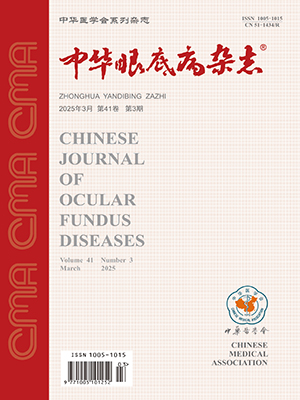| 1. |
Barradas AM, Monticone V, Hulsman M, et al. Molecular mechanisms of biomaterial-driven osteogenic differentiation in human mesenchymal stromal cells[J]. Integr Bio (Camb), 2013, 5(7):920-931.DOI:10.1039/c3ib40027a.
|
| 2. |
Scalinci SZ, Scorolli L, Corradetti G, et al.Potential role of intravitreal human placental stem cell implants in inhibiting progression of diabetic retinopathy in type 2 diabetes:neuroprotective growth factors in the vitreous[J]. Clin Ophthalmol, 2011, 5:691-696. DOI:10.2147/OPTH.S21161.
|
| 3. |
Ezquer ME, Ezquer FE, Arango-Rodríguez ML, et al.MSC transplantation:a promising therapeutic strategy to manage the onset and progression of diabetic nephropathy[J]. Biol Res, 2012, 45(3):289-296.DOI:10.4067/S0716-97602012000300010.
|
| 4. |
Xu Y, Gu Z, Shen B, et al. Roles of Wnt/β-catenin signaling in retinal neuron-like differentiation of bone marrow mesenchymal stem cells from nonobese diabetic mice[J]. J Mol Neurosci, 2013, 49(2):250-261.DOI:10.1007/s12031-012-9917-z.
|
| 5. |
Yu Q, Liu L, Duan Y, et al. Wnt/β-catenin signaling regulates neuronal differentiation of mesenchymal stem cells[J]. Biochem Biophys Res Commun, 2013, 439(2):297-302. DOI:10.1016/j.bbrc.2013.08.030.
|
| 6. |
Koen V, Niels H, Karen H, et al. Secondary progressive in contrast to relapsing-remitting multiple sclerosis patients show a normal CD4+ CD25+ regulatory T-cell function and Foxp3 expression[J]. J Neuro sci Res, 2006, 83(8):1432-1446. DOI:10.1002/jnr.20852.
|
| 7. |
Hueehn J, Polansky JK, Hamann A.Epigenetic control of Foxp3 expression:the key to a stable regulatory T cell lineage?[J]. Nat Rev Immunol, 2009, 9(2):83-89.DOI:10.1038/nri2474.
|
| 8. |
Janson PCL, Winerdal ME, Marits P, et al. Foxp3 promoter demyelination reveals the committed Treg regulation in humans[J/OL]. PLoS One, 2008, 3(2):1612[2008-02-20]. http://dx.plos.org/10.1371/journal.pone.0001612. DOI:10.1371/journal.pone.0001612.
|
| 9. |
Brouwers O, Niessen PM, Ferreira I, et al. Overexpression of glyoxalase-I reduces hyperglycemia-induced levels of advanced glycation end products and oxidative stress in diabetic rats[J]. J Biol Chem, 2011, 286(2):1374-1380.DOI:10.1074/jbc.M110.144097.
|
| 10. |
Nguyen DV, Shaw LC, Grant MB. Inflammation in the pathogenesis of microvascular complications in diabetes[J]. Front Endocrinol (Lausanne), 2012, 3:170. DOI:10.3389/fendo.2012.00170.
|
| 11. |
Yang Z, Li K, Yan X, et al.Amelioration of diabetic retinopathy byengraft ed human adipose-derived mesenchymal stem cells in streptozotocin diabetic rat s[J].Graefe's Arch Clin Exp Ophthalmol, 2010, 248(10):1415-1422. DOI:10.1007/s00417-010-1384-z.
|
| 12. |
Chao KC, Chao KF, Fu YS, et al. Islet-like clusters derived from mesenchymal stem cells in Wharton's Jelly of the human umbilical cord for transsplantation to control type 1 diabetes[J/OL]. PLoS One, 2008, 3(1):1451[2008-01-16]. DOI:10.1371/journal.pone.0001451.
|
| 13. |
Tsai PJ, Wang HS, Shyr YM, et al.Transplantation of insulin-producing cells from umbilical cord mesenchymal stem cells for the treatment of streptozotocin-induced diabetic rats[J].J Biomed Sci, 2012, 19:47. DOI:10.1186/1423-0127-19-47.
|
| 14. |
Liao W, Zhong J, Yu J, et al.Therapeutic benefit of human umbilical cord derived mesenchymal stromal cells in intracerebral hemorrhage rat:implications of anti-inflammation and angiogenesis[J].Cell Physiol Biochem, 2009, 24(3-4):307-316.DOI:10.1159/000233255.
|
| 15. |
Res PCM, Piskin G, de Boer OJ, et al.Overrepresentation of IL-17A and IL-22 producing CD8 T cells in lesional skin suggests their involvement in the pathogenesis of psoriasis[J/OL]. PLoS One, 2010, 5(11):14108[2010-11-24].http://dx.plos.org/10.1371/journal.pone.0014108. DOI:10.1371/journal.pone.0014108.
|
| 16. |
Coimbra S, Oliveira H, Reis F, et a1.Interleukin (IL)-22, IL-17, IL-23, IL-8, vascular endothelial growth factor and tumour necrosis factor-alpha levels in patients with psoriasis before, during and after psoralen-ultraviolet A and narrowband ultraviolet B therapy[J].Br J Dermatol, 2010, 163(6):1282-1290.DOI:10.1111/j.1365-2133.2010.09992.x.
|
| 17. |
Dardalhon V, Korn T, Kuchroo VK, et al. Role of Thl and Thl7 cells in Organ-specific autoimmunity[J].J Autoimmun, 2008, 31(3):252-256.
|
| 18. |
Di Cesare A, Di Meglio P, Nestle FO.The IL-23/Th 17 axis in the immunopathogenesis of psoriasis[J].J Invest Dermatol, 2009, 129(6):1339-1350.DOI:10.1038/jid.2009.59.
|




